Cats (Felis catus) and senior citizens make an unbeatable team! Studies show that seniors who own pets feel less depressed and lonely. Simply having a cat around encourages seniors to form positive emotional bonds. Petting a cat has been shown to reduce blood pressure. Taking care of a cat encourages seniors to increase their amount of movement. While the health benefits are undeniable and provable, the question of what kind of cat a senior should adopt remains.
What Breed of Cat is Best for Seniors to Own?
Like people, cats have different temperaments and energy levels. Finding a cat that meshes with your personality, lifestyle, and physical limitations is essential to creating a welcoming environment. More active seniors may enjoy having a boisterous cat in their homes. Others would be happier with a more easy-going cat. Here is an in-depth look at some breeds that seniors may consider making part of the family.
Plan for the Future
As sad as it is, there’s always the chance that a cat’s owner may pass away, leaving the animal alone. Cats can live anywhere from five years to more than 20 years! Make sure there is a backup plan in place by naming a person or organization to take care of the cat in the event of the owner’s death.
#1 British Shorthair
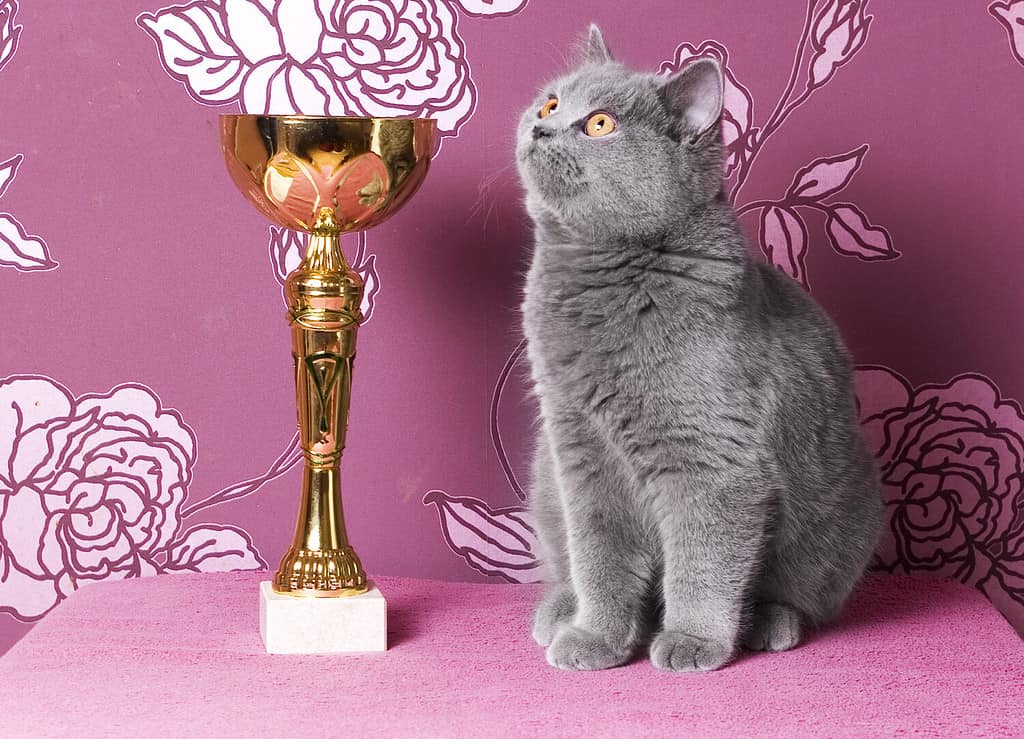
British Shorthairs are smart and easily trained to do tricks.
©Joanna Zaleska/Shutterstock.com
Loyal and affectionate, the British Shorthair has a reserved temperament. Unlike more active breeds, the British Shorthair is content to sit beside its owner rather than climb into your lap and beg for scratches. Adult females weigh up to 11 pounds on average, and adult males reach 16 pounds. Their low energy level and independent nature may be perfect for seniors who don’t want a cat with consistently wild behavior patterns.
#2 Exotic Shorthair
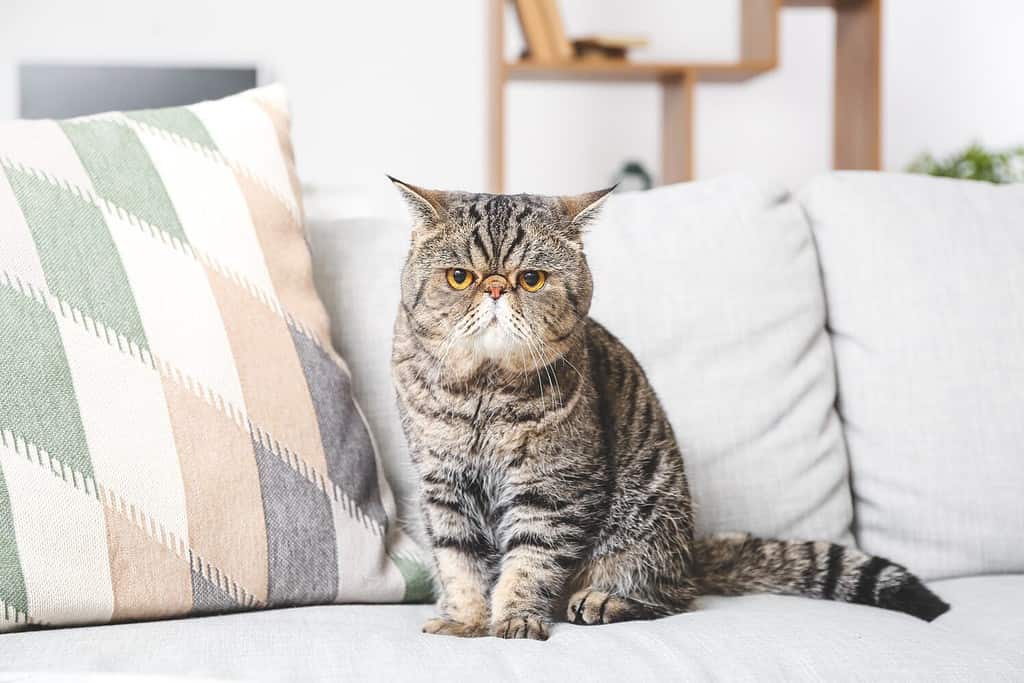
Because of their low energy level, Exotic Shorthairs are a good choice for seniors who live in apartments.
©Pixel-Shot/Shutterstock.com
Selectively bred to incorporate the traits of a Persian cat without long hair, the Exotic Shorthair is a friendly cat. On average, Exotic Shorthairs weigh anywhere from eight to 13 pounds. They love to explore their surroundings on occasion but may have to be persuaded to get daily exercise. Instead of meowing, Exotic Shorthairs “talk” with chirps and trills. Exotic Shorthairs don’t shed a lot, but experts recommend a weekly brushing to decrease both tangling and the possibility of hairballs. Despite the minimal shedding, seniors with cat allergies could have an adverse reaction to this breed.
#3 Himalayan
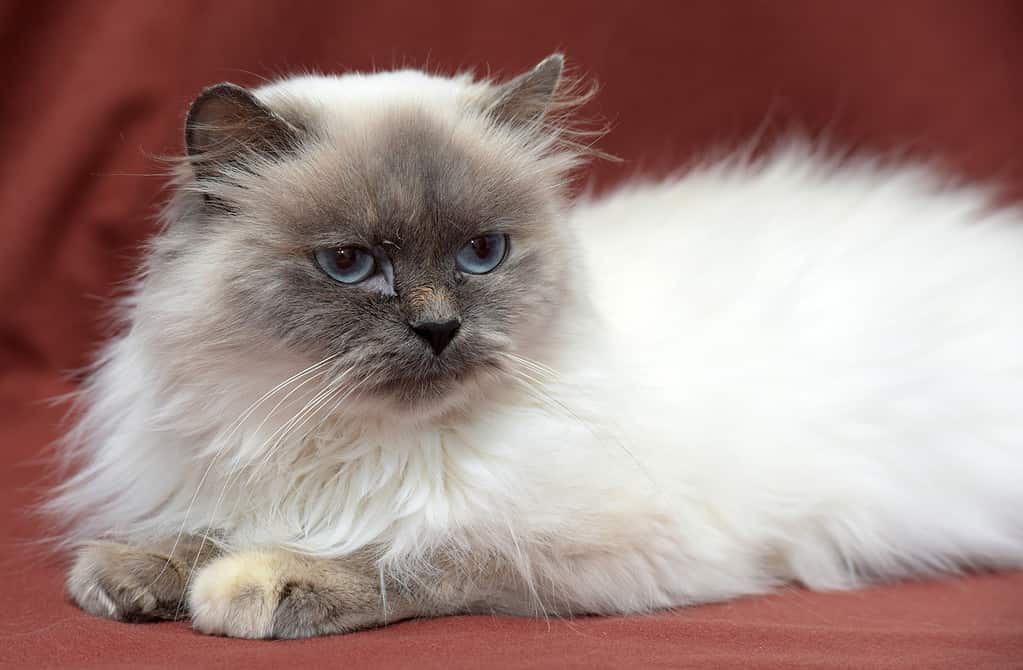
Himalayan cats are good around children and grandchildren!
©Anna Krivitskaya/Shutterstock.com
It’s all about the fur with Himalayan cats. These medium-sized cats appear much larger than they are because of their dense coat! They will need to be brushed on a daily basis to prevent tangles or matted fur. Himalayans have random bursts of energy, in which they run around like mad. For the most part, Himalayans are calm creatures who like to keep you company while you go about your daily routine. Seniors who live in a quiet place should consider the Himalayan as a new furry friend.
#4 Persian
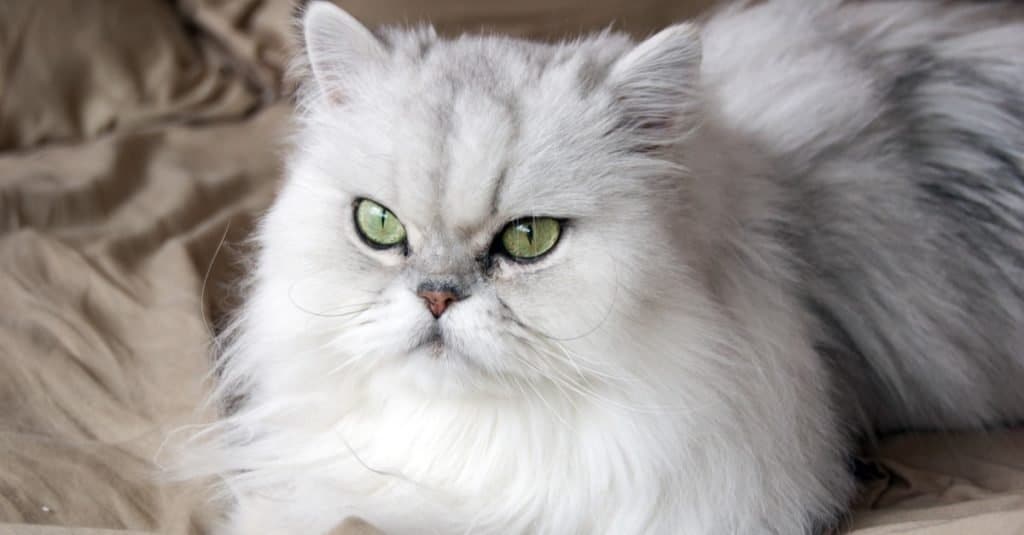
If you’re not a fan of loud noises, the Persian is a docile cat.
©pavels/Shutterstock.com
One of the most popular breeds of cat in the U.S., the Persian is lauded for its long lush coat. A medium-to-large-sized cat, adult Persians can weigh as much as 12 pounds. Persians are a tad persnickety. Naturally affectionate, Persians don’t like rough play or being picked up and hauled around by curious humans. Let them find a quiet spot in your home and let them observe. When they need some attention, they’ll come to you! Although the Persian is a low-energy cat, their fur requires daily attention. Matted fur is a problem for Persians, so brushing and combing their dense coat is a necessity. That high level of maintenance is something for seniors to consider before welcoming a Persian into their household.
#5 Ragdoll
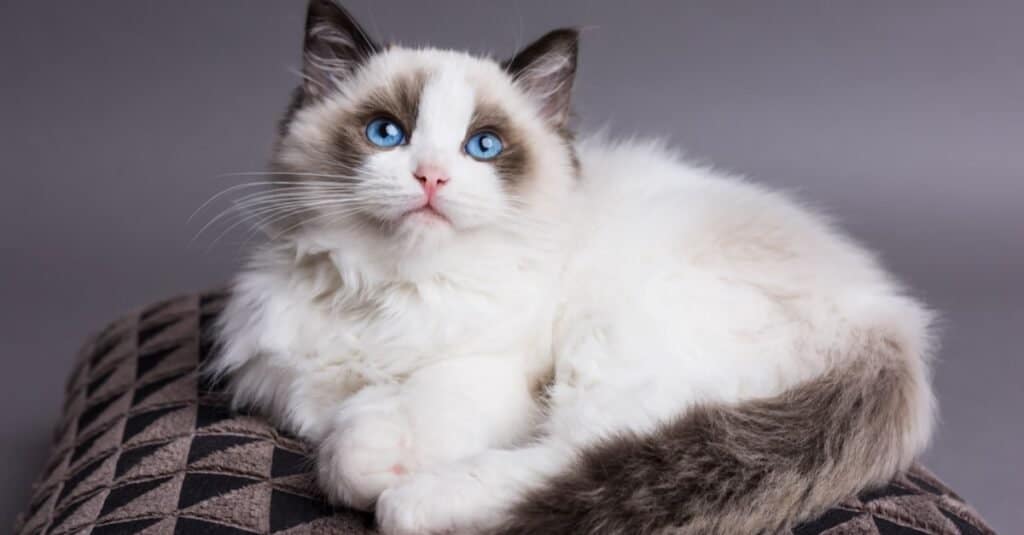
Ragdolls are revered as one of the largest domestic cat breeds.
©madeinitaly4k/Shutterstock.com
Adult Ragdolls can reach up to 20 pounds. That’s a big cat! Don’t be intimidated by their size. Ragdolls are highly affectionate and friendly. When they are picked up, they relax their muscles and get limp and floppy while being petted. Scheduling playtime is important for Ragdolls. Classified as low-energy cats, Ragdolls have a tendency to become obese so physical activity is important for their overall health. Seniors with limited mobility may wish to choose another breed. For many seniors, though, the Ragdoll’s intelligence and loyalty make them an excellent choice for older pet-seekers.
#6 Ragamuffin
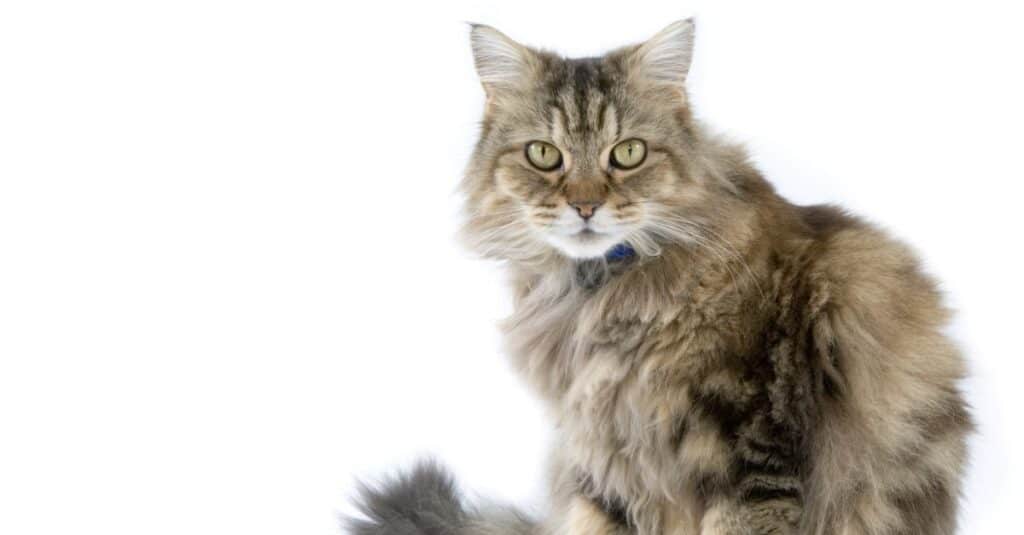
Ragamuffin kittens are born white, with colors and markings appearing as they mature.
©Scampi/Shutterstock.com
Related to the Ragdoll breed, the Ragamuffin shares the tendency to go limp when picked up. Ragamuffins are large cats, with adult males hitting 20 pounds, if not more. They have a low energy level and are often described as docile, making them great lap cats. Ragamuffins have loads of soft fur which is naturally resistant to tangles. They are prone to shedding. Combing the Ragamuffin’s coat once a week with a comb is recommended.
#7 Scottish Fold

These cats like to sit on their backs like humans, a position some Scottish Fold owners call the “Buddha” pose.
©DK13/Shutterstock.com
Named for their distinctive ears, which fold forward on their heads, Scottish Folds are a sweet breed of cat. They are attentive to their owners. You may wonder if you own the Scottish Fold or if they own you! Generally a medium-sized cat, the Scottish Fold is a good jumper that likes to find high places in its environment. Even so, it is a low-energy breed that enjoys lying about on the floor or a nice warm lap. Scottish Folds are prone to ear infections. Cleaning their ears on a regular basis will help minimize that possibility.
#8 Birman
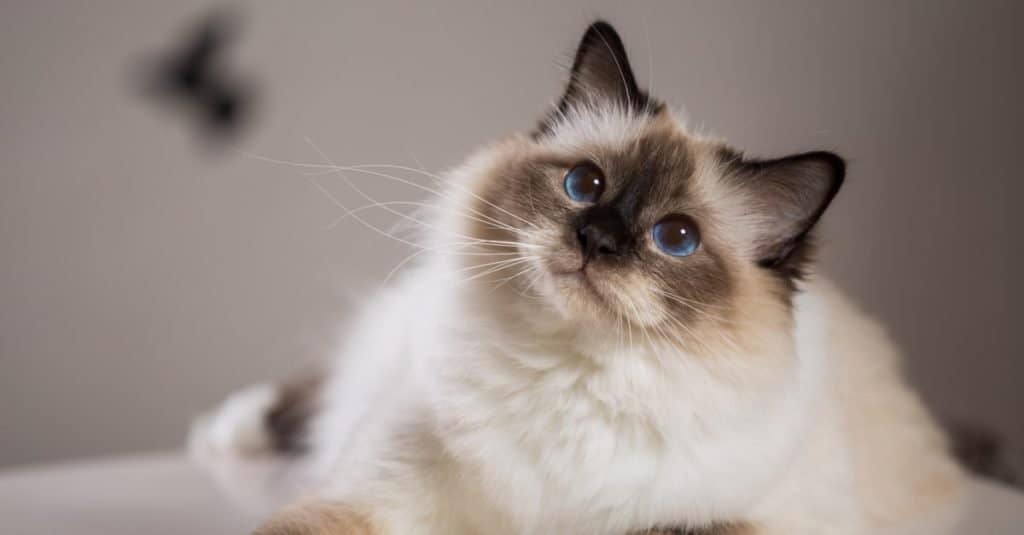
Where the Birman originated is a mystery. Some say it came from Myanmar while others say it is a French breed.
©Borkin Vadim/Shutterstock.com
Only available in the U.S. since the 1950s, the calm Birman is an affable, good-natured cat. Birmans have a coat of smooth long hair with only one layer. Weekly brushing is recommended to keep their fur in shape. On average, Birmans grow to a weight of between seven to 12 pounds and are thought of as medium-to-large cats. Birmans are loving and affectionate to their owners, but reticent to warm up to strangers. Seniors who enjoy entertaining in their homes may find their Birman skittish when new people enter their environment. In general, Birmans are low-energy pets that return affection as it is given.
#9 American Shorthair
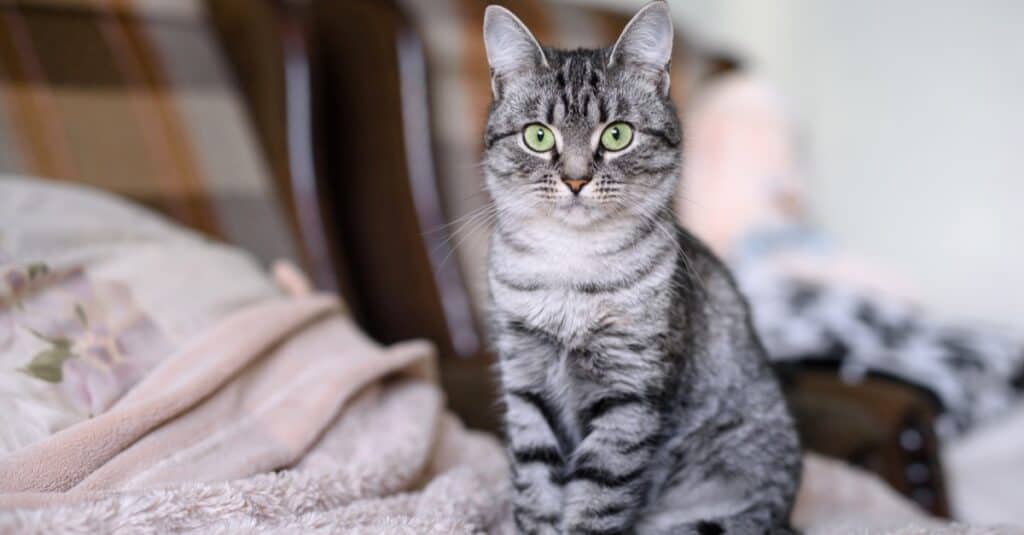
This breed exhibits a wide variety of coat coloration, markings, and patterns.
©Lalandrew/Shutterstock.com
Even-tempered and moderately playful, the American Shorthair represents the classic vision of a cat. With strong legs and a stocky build, the American Shorthair came to the U.S. on the Mayflower where they kept vermin away from food stores. They are comfortable in a full house or by themselves. American Shorthairs have a tendency to patrol their areas, keeping an eye on activities and people. A medium-to-large-sized cat, adult American Shorthairs can weigh between eight and twelve pounds. Although they enjoy curling up in your lap, they spend a good deal of time keeping to themselves. Not too demanding but still clingy enough to want some undivided attention, the American Shorthair would adapt well to living with a senior.
#10 Russian Blue
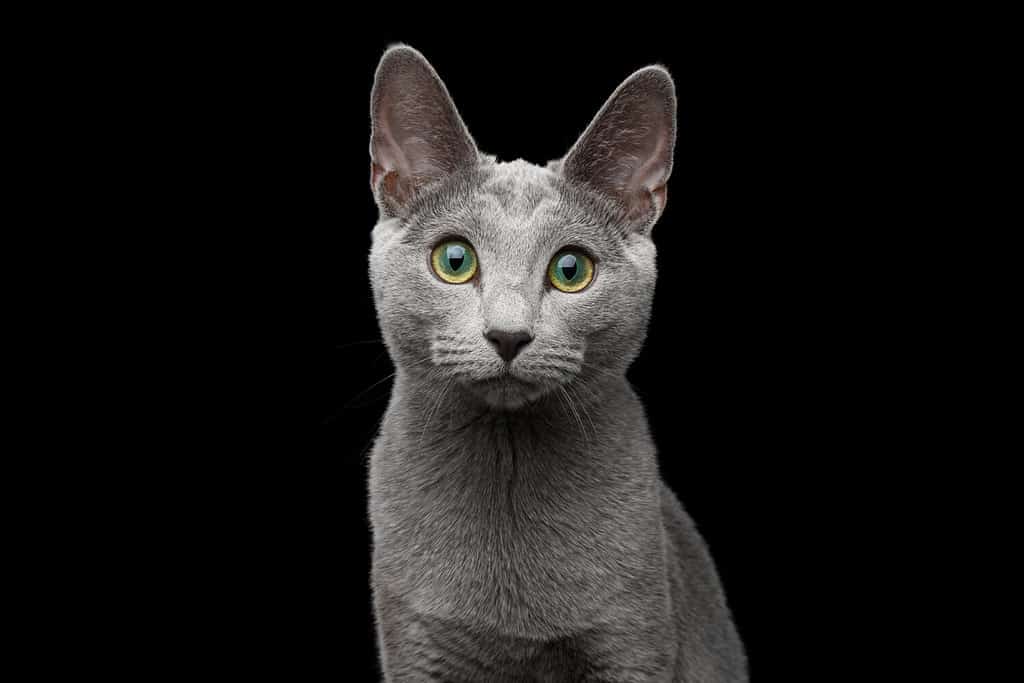
Some individual Russian Blues have had a lifespan of over two decades!
©Seregraff/Shutterstock.com
With blue-hued fur and striking green eyes, the Russian Blue is a gorgeous cat. Normally medium-sized, the adult Russian Blue can weigh between six and 15 pounds. Russian Blues like to eat, and obesity is a danger for this breed. They love routine and do not adapt well to change. Regimented lifestyles suit the Russian Blue. These cats love to communicate, often with loud cries and yowls. It may seem like they are trying to hold a conversation with you! Climbers by nature, Russian Blues observe their surroundings from high points in the home, such as countertops or the tops of cabinets. If a “talking” cat appeals to a senior you know, consider helping them find a Russian Blue!
#11 Maine Coon

A Maine Coon’s tail is often as long as its body!
©kukurund/Shutterstock.com
The official cat of the state of Maine, the Maine Coon is a long-haired cat known for its size. It takes four years for a Maine Coon to reach full maturity. Adult females often top out at around 15 pounds while adult males can weigh up to 22 pounds. Maine Coons are excellent companion cats. Not too clingy, Maine Coons enjoy hanging around their owners without demanding inordinate amounts of attention. They have a sweet personality. Unlike some felines, many Maine Coons enjoy being in the water!
#12 Bombay

Not only is the fur of the Bombay black but so is their nose!
©antonella.lussardi/Shutterstock.com
Expect the Bombay cat to act as your shadow kitty. Always black with a shorthair coat, the panther-like Bombay loves to be around its owners. They’ll climb into your lap or lay at your feet. For all of its sociability, the Bombay is a medium-energy cat. Adults can grow to a weight of between eight to 15 pounds. Bombays love to play, but mature Bombays focus their attention on other members of the household. Their amiable attitude means they do not like to spend a lot of time by themselves. Bombay cats are best suited for seniors who spend most of their time at home or who already have other cats.
#13 Pixiebob
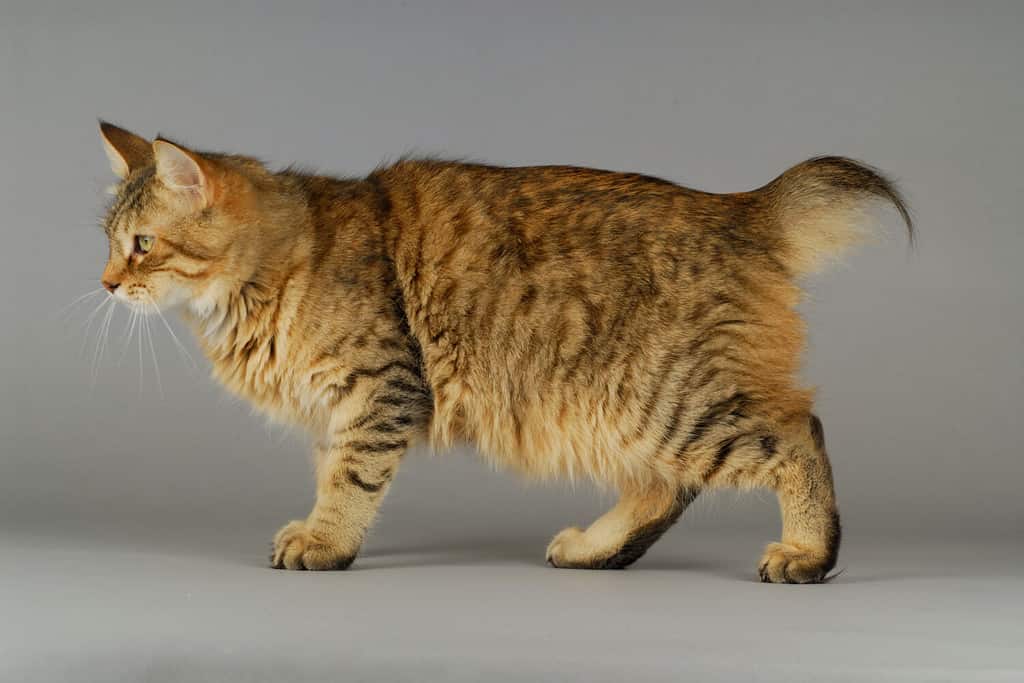
The condition that cause Pixiebobs to have more toes than normal on some paws is called “polydactyly.”
©COULANGES/Shutterstock.com
Although they resemble a wild bobcat, Pixiebobs have been described as dog-like in their loyalty and behavior. Intelligent cats, Pixiebobs can be taught to play fetch. They love to be involved in all manner of household activities. These cats don’t meow. Instead, they use chirps, purrs, and trills to communicate. Their tails are short because of a genetic mutation, but Pixiebobs grow large. Adult males are known to be a foot tall and weigh around 14 pounds. Pixiebobs are also known for their rounded paws, some of which will exhibit extra toes! Interested in daily events but not generally needy, Pixiebobs make excellent companion animals.
#14 Chartreux
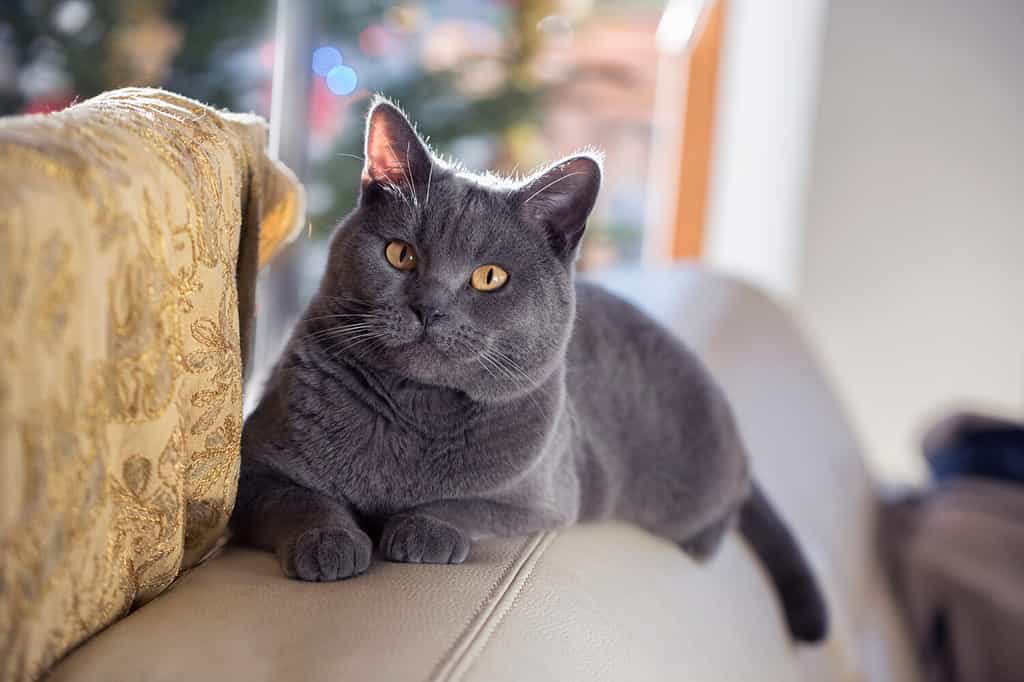
What an honor! The Chartreux is the National Cat of France.
©Katniss studio/Shutterstock.com
Mellow and reserved, the Chartreux doesn’t need to be the main character. It is content during periods of alone time. Mature adults are not given to leaping, although they enjoy climbing. Chartreux owners would do well to purchase a cat tree, allowing the cat to perch in a high area and scan its surroundings. These are grey-coated, medium-sized cats, with mature adult males weighing around 12 pounds. Chartreux cats are great for seniors looking for a calm, gentle housecat.
#15 American Bobtail
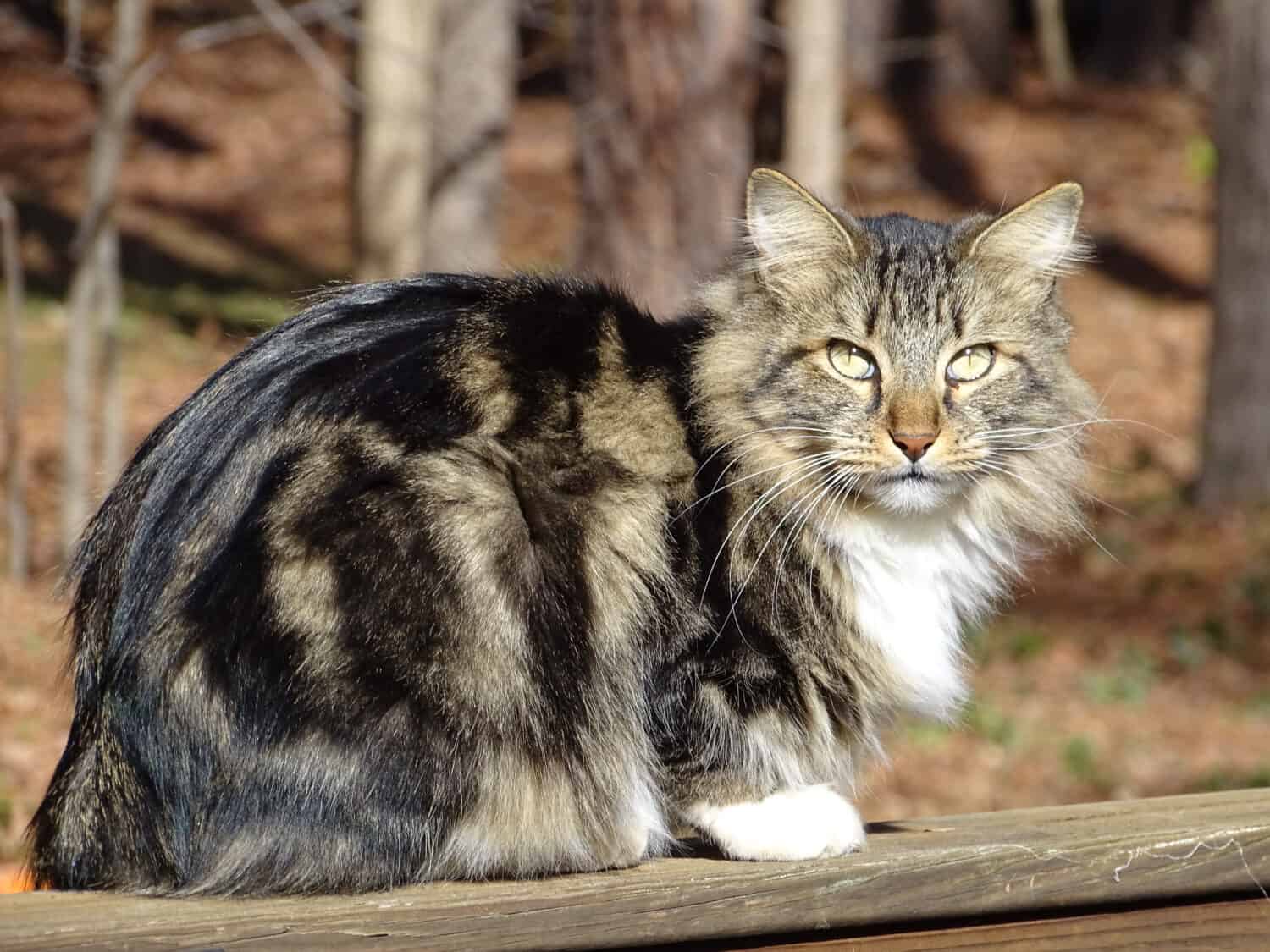
It could take up to three years for an American Bobtail to reach full maturity.
©Mary McDonald/Shutterstock.com
Notable for their short tails, a genetic feature created by cat breeders, American bobtails are playful cats. On average, they weigh between 8-16 pounds. Their coat features medium to long hair in every color and pattern imaginable. American bobtails have muscular bodies reminiscent of wild cats. An extremely friendly and affectionate breed, American bobtails are an excellent choice for seniors desiring companionship. However, their rambunctiousness may be a drawback for people with low energy. American bobtails also shed quite a bit, posing a problem for seniors who have difficulties with housecleaning.
#16 American Curl
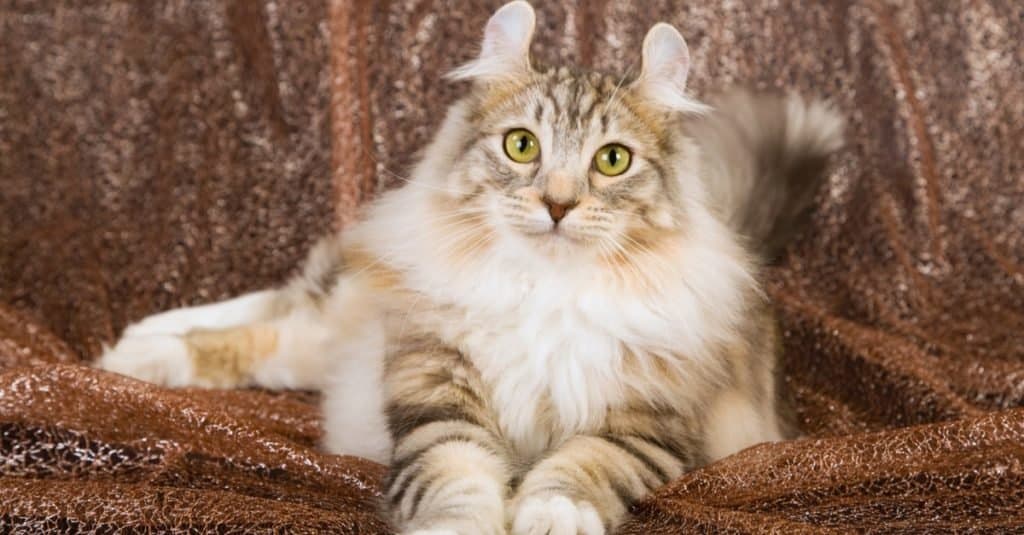
Despite being known for their curled ears, American Curl kittens are born with straight ears.
©Linn Currie/Shutterstock.com
So named for their curling ears, the American Curl makes an excellent companion for active seniors. Naturally inquisitive, this cat likes to explore and climb. Mature American Curls weigh an average of 5-10 pounds. You can find both longhaired and shorthaired varieties in all manner of coloration. American Curls are attentive pets, but some seniors may find that American Curls can get underfoot while doing ordinary tasks. But if it is a loyal and loving pet you seek, the American Curl will fit the bill.
#17 Manx

Got mice? The Manx is highly skilled at catching rodents.
©slowmotiongli/Shutterstock.com
When you first encounter a Manx, you’ll notice right away that they have no tail! That’s not a detriment to the Manx. This breed has strong hind legs that are longer than the front legs, allowing them to jump to the highest areas of a room. Don’t be surprised to find your Manx on top of tall pieces of furniture! Manx are medium-sized cats with adults weighing between 8-14 pounds. Smart and social, the Manx does not like being left to its own devices for prolonged periods of time. Seniors may decide the affection and loyalty of the Manx may outweigh its sporadic moments of rambunctious behavior.
#18 Burmese
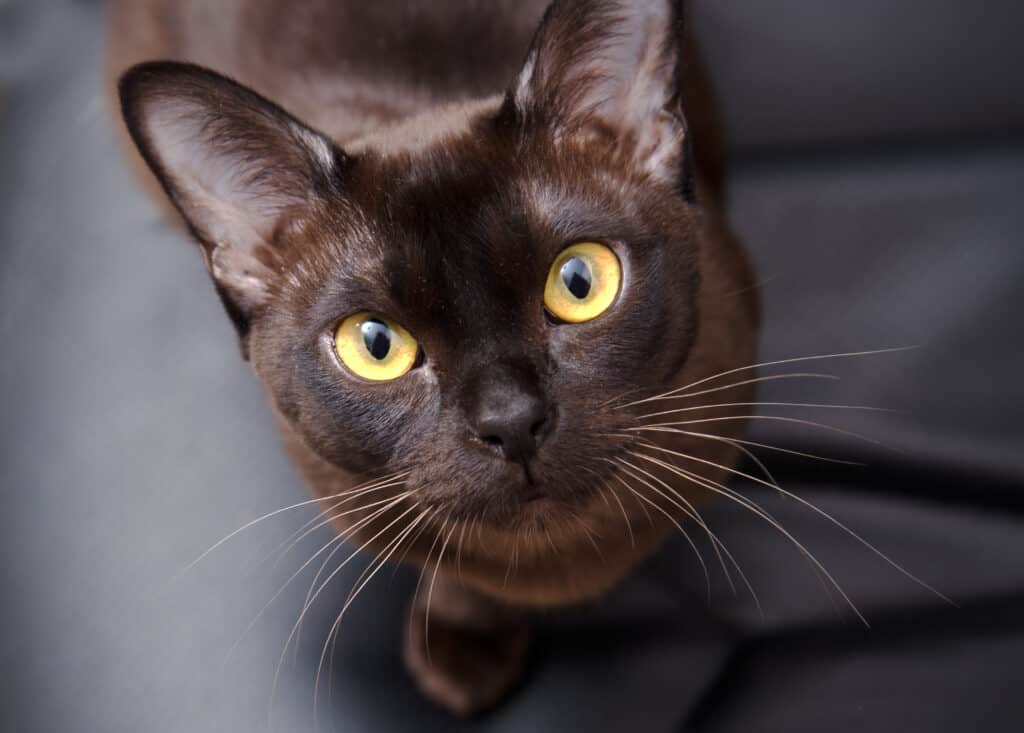
Due to their trust and dependence on their owners, it’s best to keep Burmese cats inside.
©woff/Shutterstock.com
With piercing yellow-gold eyes and a loving disposition, Burmese cats fit the definition of the phrase “sweet kitty” to a T. Male Burmese are larger than females, often weighing 12 pounds or more. One expects kittens to be full of energy, but adult Burmese cats also love to play and be the center of attention. Eager to please, some Burmese cats can be taught to perform tricks! Burmese cats may sometimes try your patience with their demands for attention, but they are both affectionate and loyal.
#19 Abyssinian
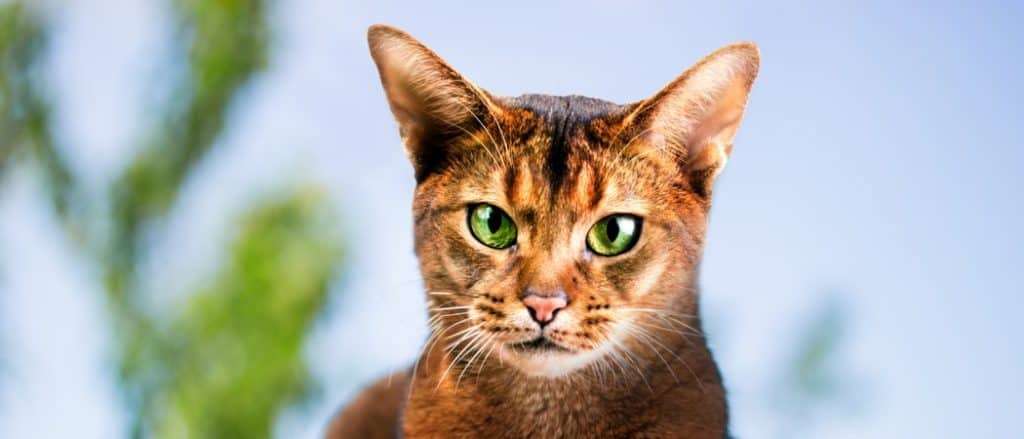
Dental health is important for the
Abyssinian
breed, which is prone to gingivitis.
©Kyselova Inna/Shutterstock.com
You may be taken aback by the appearance of the Abyssinian. With its tabby-like markings, medium-sized sleek body, and tufted ears, the Abyssinian looks like it wandered in from the forest primeval. There’s no reason to be afraid. Abyssinians are highly social, loving, and loyal pets. They are curious about their surroundings and attempt to be involved somehow in household activities. High-energy creatures, Abyssinians don’t stay in one place for long. They love to climb and explore. While they love to be around people, Abyssinians aren’t the kind to spend an hour on your lap. Seniors should decide if they have enough energy during the day (and possibly night) to keep up with an Abyssinian!
#20 Munchkin

Sometimes called “sausage cats,” Munchkins look like kittens even after reaching full maturity.
©FreelanceGhostwriting/Shutterstock.com
These little cats were built for speed! Classified as a small-to-medium-sized breed, Munchkins have very short legs. This is due to a natural genetic mutation that affects their bone structure. They love to run around the house with surprising accuracy, taking sharp corners with ease and grace. Mature adults normally weigh less than 10 pounds. Just because they’re tiny doesn’t make Munchkins less curious. They are insatiable explorers, even if it takes them a little longer to arrive at their destination. Affectionate and well-tempered, Munchkins are a delightful breed. However, purchasing a Munchkin may be cost-prohibitive. Buying a Munchkin from a breeder could cost you upwards of $1,000.
#21 Bengal
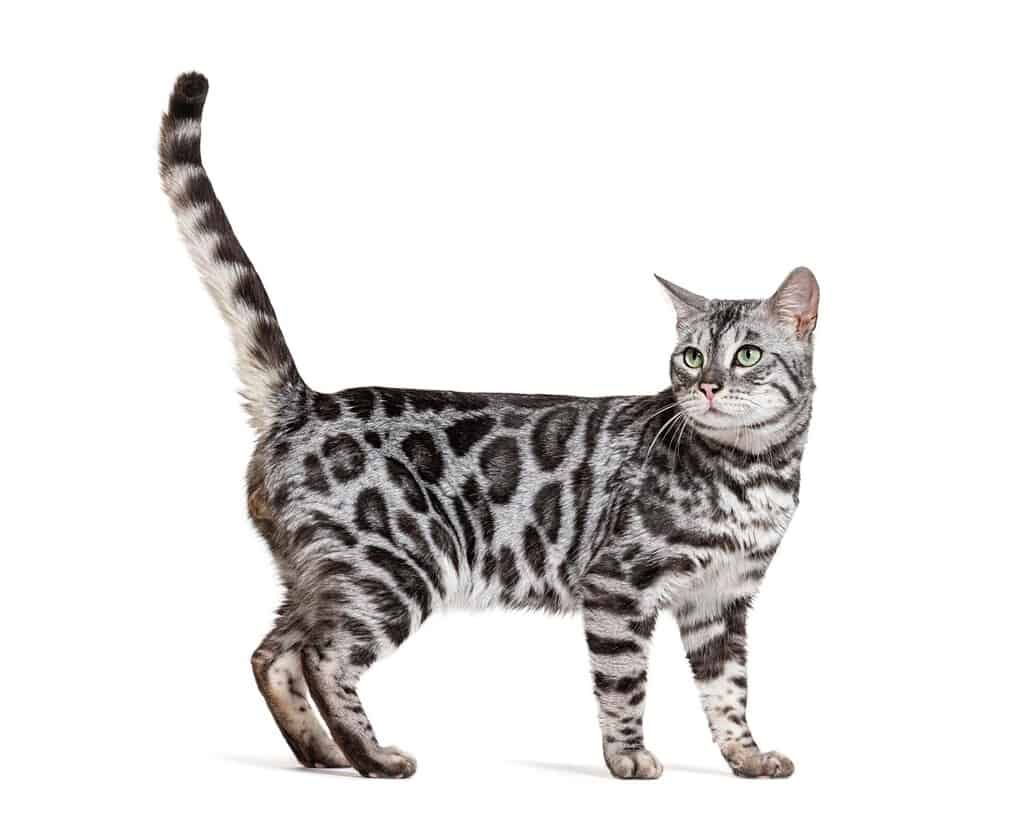
Brown, snow, and silver (shown above) are common coat colors for the Bengal breed.
©Eric Isselee/Shutterstock.com
Independent and strong-willed even in domesticated households, Bengal cats look like they came straight from the jungle. They can have markings like leopards or tigers. These cats can grow to be large. Mature Bengals range from six to 15 pounds. Bengals are active and inquisitive and they love to climb. Their energetic disposition may be perfect for an active senior who doesn’t mind having a pet who spends most of their time on the go.
#22 Devon Rex
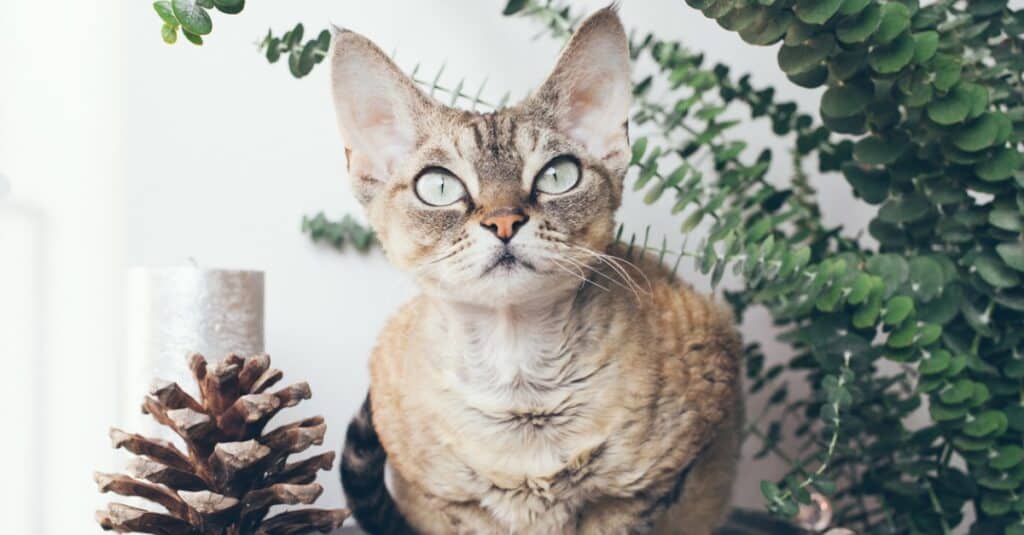
With a wavy coat that inhibits shedding, the Devon Rex rarely causes allergic reactions in humans.
©Veera/Shutterstock.com
A medium-sized cat, the Devon Rex is recognizable by its big bat-like ears and large ears. This breed is an adorable ball of energy. Not shy about showing affection, the Devon Rex enjoys not only humans, but the company of other animals. It loves to play with its owner but becomes bored easily. Some seniors may find it difficult to keep up with the Devon Rex. Others may love having a pet that requires lots of attention. If the latter proves true, then the Devon Rex may be the perfect pet to join a senior’s household.
#23 Sphynx
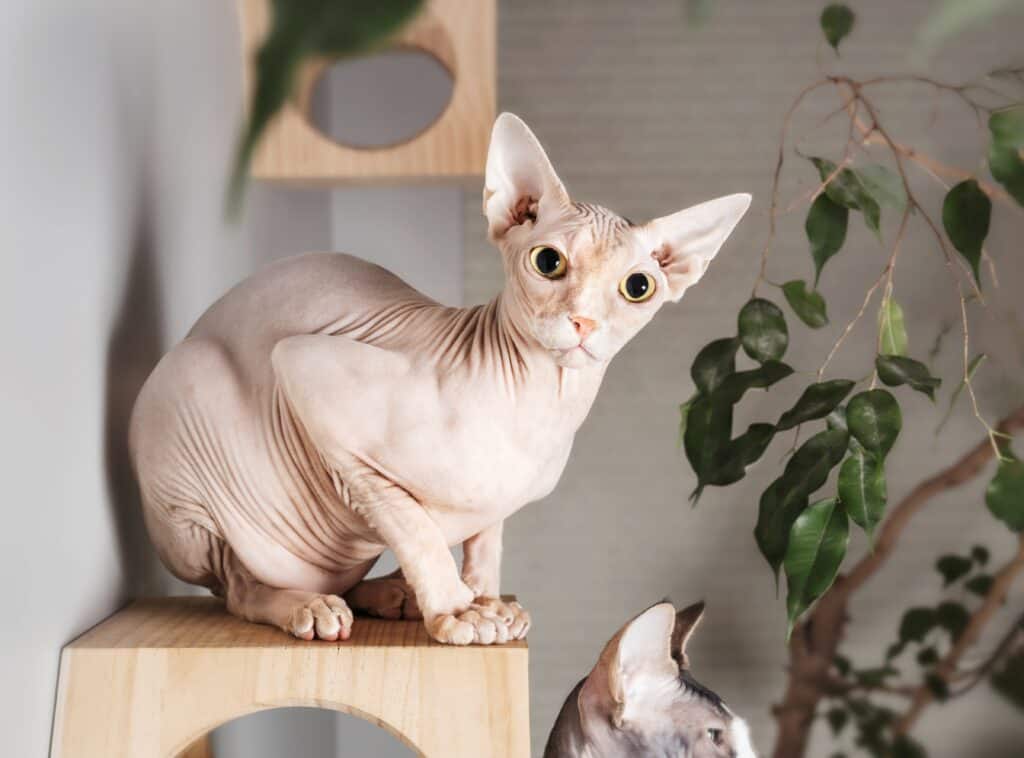
Because of their thin coats, the Sphynx enjoys finding warm places to relax.
©sophiecat/Shutterstock.com
At first glance, the Sphynx appears to be hairless. Its skin is visible, but the Sphynx has a coat of very short and fine fur. The Sphynx is a small-to-medium-sized cat, with a weight range of six to 12 pounds. It is an energetic breed that loves to play. Since its coat is practically non-existent, the Sphynx requires weekly bathing to prevent dirt build-up and dry patches on its skin. The Sphynx thrives as an indoor pet and does not like to be left alone.
#24 Siberian

With their thick fur, Siberians are considered to be the most cold weather resistant breed.
©barmalini/Shutterstock.com
Originally bred in Russia, the Siberian looks ready for a harsh winter! In cold weather, Siberians grow a triple-layered coat to stay warm and adapt to the elements. They’ll appreciate a good brushing every week. Siberians are large animals, with mature male adults weighing around 20 pounds. Females are smaller, generally topping out at 15 pounds. Siberians are roamers, and they have tons of energy to expend. Despite this, Siberians have a calm, even-tempered disposition. Seniors may appreciate the Siberian as a quiet companion animal that combines boisterousness with sweetness.
#25 Balinese
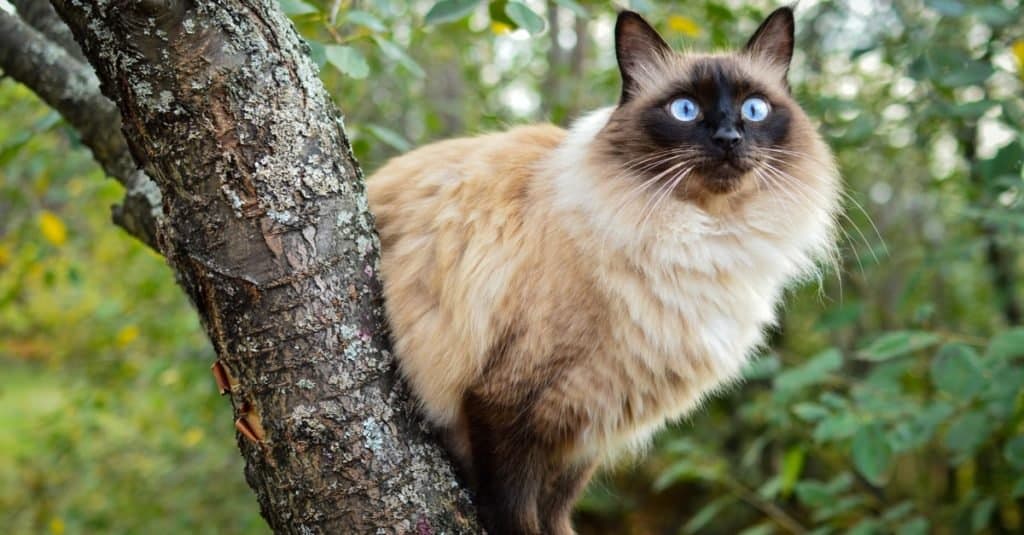
Although the Balinese is an intelligent breed of cat, they can become bored easily.
©Fazlyeva Kamilla/Shutterstock.com
A variety of the Siamese breed, the Balinese is notable for its smooth coat and puffy tail. A medium-to-large-sized cat, the Balinese can weigh up to 12 pounds or more. Balinese cats are friendly and social, and can become distressed or destructive if left alone for prolonged periods. They are highly energetic and will react positively to periods of playtime. You’ll know when a Balinese wants your attention. These cats are vocal and will communicate with insistent meowing and purring. Balinese cats are best suited for households where they will be kept company for long stretches of time by a loving and attentive owner.
#26 Mixed Breed
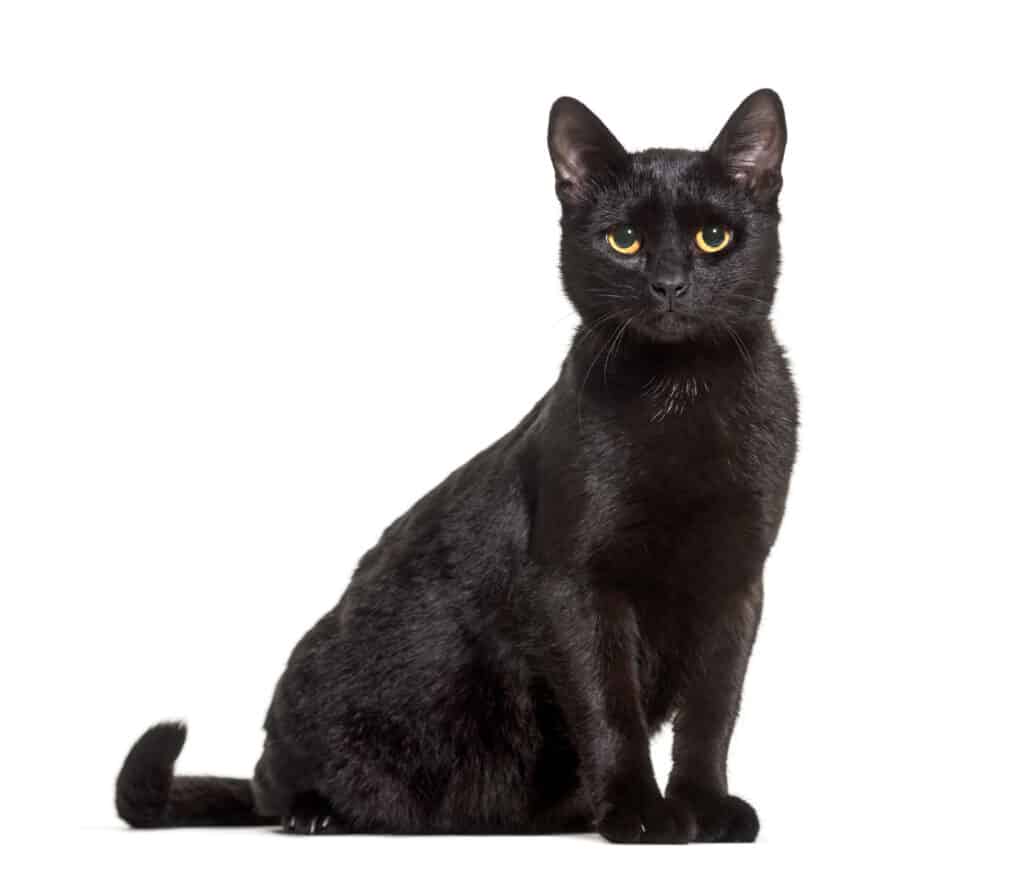
You can find Mixed-breed cats in all sizes, lengths of coats, and colorations.
©Eric Isselee/Shutterstock.com
Also known as “moggies,” mixed-breed cats are a great option for seniors looking to bring a pet cat home. Mixed-breed cats are often found at animal shelters. Shelters and animal rescue facilities are excellent places to find older cats that won’t be as energetic as kittens or younger cats. While temperaments and behavior patterns vary from cat to cat, mixed-breed cats are generally friendly and affectionate. Some may suffer from trauma and be needier than younger cats. They may require more attention and care but, with patience, a mixed-breed cat could become a senior’s best friend.
Summary of the 26 Best Cat Breeds for Seniors
| Breed Name | Temperament | Energy level | Size | |
|---|---|---|---|---|
| 1 | British Shorthair | reserved, loyal | low | medium to large |
| 2 | Exotic Shorthair | friendly, vocal | low | medium to large |
| 3 | Himalayan | calm, quiet | low | medium |
| 4 | Persian | reserved, affectionate | low | medium to large |
| 5 | Ragdoll | affectionate, social | low | large |
| 6 | Ragamuffin | affectionate, calm | low | large |
| 7 | Scottish Fold | social, loyal | low | medium |
| 8 | Birman | affectionate, shy | low | medium to large |
| 9 | American Shorthair | affectionate, reserved | medium | medium to large |
| 10 | Russian Blue | vocal, observant | medium | medium to large |
| 11 | Maine Coon | even-tempered, reserved | medium | large |
| 12 | Bombay | social, affectionate | medium | medium to large |
| 13 | Pixiebob | intelligent, loyal | medium | medium to large |
| 14 | Chartreux | reserved, gentle | medium | small to medium |
| 15 | American Bobtail | friendly, affectionate | high | medium to large |
| 16 | American Curl | curious, attentive | high | small to medium |
| 17 | Manx | social, inquisitive | high | medium |
| 18 | Burmese | intelligent, affectionate | high | medium to large |
| 19 | Abyssinian | social, loyal | high | medium |
| 20 | Munchkin | curious, well-tempered | high | small to medium |
| 21 | Bengal | active, independent | high | medium to large |
| 22 | Devon Rex | affectionate, social | high | medium |
| 23 | Sphynx | social, playful | high | small to medium |
| 24 | Siberian | even-tempered, docile | high | large |
| 25 | Balinese | social, vocal | high | medium to large |
| 26 | Mixed Breed (Moggy) | friendly, affectionate | variable | small to large |
The photo featured at the top of this post is © Cicafotos/Shutterstock.com
Thank you for reading! Have some feedback for us? Contact the AZ Animals editorial team.






